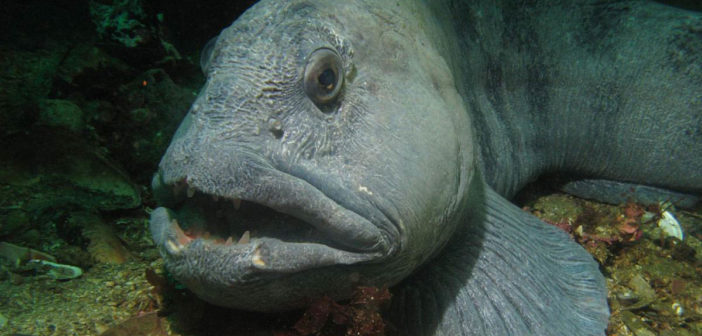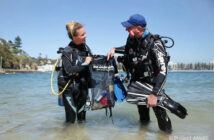With even just a brief glance, you can quickly figure out how the Atlantic wolfish was named. Their large, canine-like teeth protrude from their mouths, giving them a wolf-like scowl. Behind these visible primary canine teeth are a cluster of five or six smaller canines, as well as three sets of crushing teeth on the roof of their mouths, used to grindhard-shelled prey. In spite of their slightly ferocious appearance and large teeth, Atlantic wolfish are not aggressive. They feed on slow-moving or sedentary prey such as sea urchins, crabs, molluscs and large snails. Atlantic wolfish are also incredibly well-adapted for cold water conditions, able to survive in water below 0°C, thanks to high concentrations of an antifreeze compound in their blood.
Atlantic wolfish are a fairly large fish with an elongated, tapering body and weigh up to almost 20 kilograms. Their heads are relatively large compared to their bodies and they have blunt, rounded snouts with sharp, protruding teeth. Their dorsal fins run down their back, starting behind the head and extending all the way to the tail fin, however they lack pelvic fins which most fish have. Atlantic wolfish are typically a light greyish-green colour, but can range from olive green to purplish- or reddish-brown. They are one of three species of wolfish that can be found in Atlantic Canada, the other two being Spotted and Northern. Atlantic wolfish can be distinguished from their wolfish cousins by the nine to 13 darkly coloured, vertical bars that run the length of their body.
Atlantic wolfish become sexually mature in the northwest Atlantic at around eight to 10 years of age. They will form bonded pairs during the spring and summer and mate via internal fertilization in the fall. Females will reproduce multiple times through their lifetime, laying between 5,000 and 12,000 eggs. The number of eggs a female is able to lay increases with her size, which is why it is vitally important that large females remain in the environment to ensure population sizes are healthy. Eggs are laid in a cluster on boulders and in rocky crevices, where they will be guarded by the parental male until they hatch. Males that are guarding eggs will stop feeding and become more aggressive in their duties as a protector. Once hatched, the rather large larvae float around in the upper layers of the water column before settling to the ocean floor as juveniles. They settle into a sedentary lifestyle as they mature, setting up home in crevices on rocky reefs, only really venturing out for food or to find a mate during the spawning season. Atlantic wolfish can live to be around 20 years old.
Atlantic wolfish were assessed and listed as a Special Concern by the Committee on the Status of Endangered Wildlife in Canada (COSEWIC) in 2000, and re-listed as such in 2012. They were also listed under Schedule 1 of the Species at Risk Act (SARA) as a Special Concern in 2003. Due to their long lifespan, late maturity and low reproduction rates, Atlantic wolfish populations are slow to recover after they have been greatly reduced. This is one of the main reasons for their listings as a Special Concern, as the population of Atlantic wolfish in Canadian waters declined by 87 per cent from the late 1970’ to the mid 1990s. However, with reduced fishing pressure as a result of groundfish fishery closures and improved bycatch reduction measures, Atlantic wolfish are still fairly widespread and populations are believed to be increasing.
Some Quick Facts About the Wolfish
Also Known As
Striped wolfish, seawolf, seacat, ocean catfish
Distribution
Cold temperate to subpolar north Atlantic Ocean
EcoSystem/Habitat
Rocky reefs and hard bottoms
Feeding Habits
Aggressive predator
Conservation Status
Special concern/data deficient









